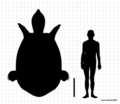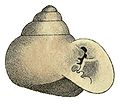
This is a list of South American animals extinct in the Holocene that covers extinctions from the Holocene epoch, a geologic epoch that began about 11,650 years before present (about 9700 BCE) [A] and continues to the present day. [1]
Contents
- Mammals (class Mammalia)
- Opossums (order Didelphimorphia)
- Armadillos, pampatheres, and glyptodonts (order Cingulata)
- Anteaters and sloths (order Pilosa)
- Elephant-like mammals (order Proboscidea)
- Rodents (order Rodentia)
- Bats (order Chiroptera)
- Carnivorans (order Carnivora)
- Notoungulates (order Notoungulata)
- Litopterns (order Litopterna)
- Odd-toed ungulates (order Perissodactyla)
- Even-toed ungulates (order Artiodactyla)
- Birds (class Aves)
- Landfowl (order Galliformes)
- Waterfowl (order Anseriformes)
- Grebes (order Podicipediformes)
- Nightjars (order Caprimulgiformes)
- Swifts, treeswifts, and hummingbirds (order Apodiformes)
- Rails and cranes (order Gruiformes)
- Shorebirds (order Charadriiformes)
- Storks and allies (order Ciconiiformes)
- New World vultures (order Cathartiformes)
- Owls (order Strigiformes)
- Parrots (order Psittaciformes)
- Perching birds (order Passeriformes)
- Reptiles (class Reptilia)
- Turtles and tortoises (order Testudines)
- Amphibians (class Amphibia)
- Frogs (order Anura)
- Ray-finned fish (class Actinopterygii)
- Catfishes (order Siluriformes)
- Toothcarps (order Cyprinodontiformes)
- Insects (class Insecta)
- Beetles (order Coleoptera)
- Bark lice, book lice, and parasitic lice (order Psocodea)
- Arachnids (class Arachnida)
- Order Mesostigmata
- Clitellates (class Clitellata)
- Order Opisthopora
- Slugs and snails (class Gastropoda)
- Order Littorinimorpha
- Order Stylommatophora
- Unassigned order
- See also
- Notes
- References
- External links
The list includes animal extinctions in the Falklands and other islands near the continent but not the Galápagos Islands, which has its own list of extinct animals. Extinct animals from the West Indies are covered in List of Antillian and Bermudan animals extinct in the Holocene. Extinctions from Easter Island, a territory of Chile in Polynesia, are covered in the List of Oceanian species extinct in the Holocene.
Many extinction dates are unknown due to a lack of relevant information.
























































